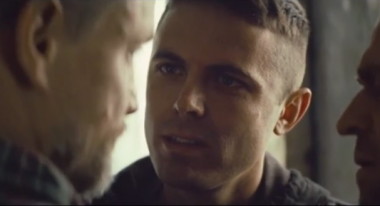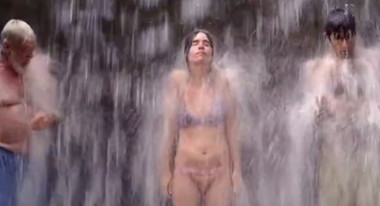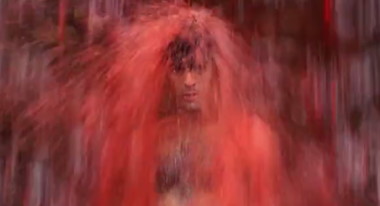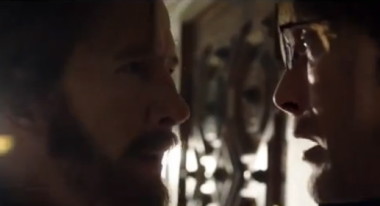 Back to selection
Back to selection
Into the Splice
Adventures of a film spectator by Nicholas Rombes
Memorable Cinematic Moments of (Mostly) 2013
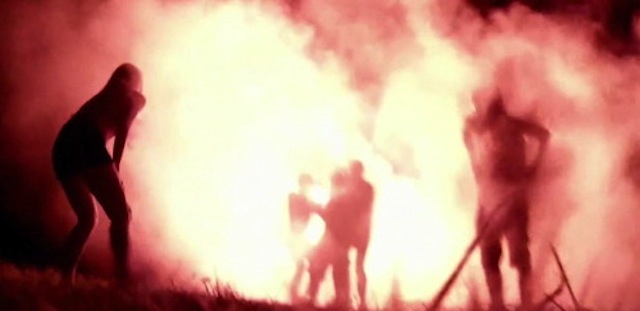
Out of the Furnace (Scott Cooper)
On the surface, the scene is familiar, verging on the clichéd, and yet it’s made unfamiliar and strange though a sort of weird tension that develops around it. Rodney Baze (Casey Affleck), a troubled Iraq war veteran who chafes at working in the Braddock, Pennsylvania, steel mills like his father and brother (Christian Bale), has convinced John Petty (Willem Dafoe), a bookie who’s deep into debt with Harlan DeGroat (Woody Harrelson), to meet with DeGoat in the Ramapo Mountains area of New Jersey, where DeGroat runs a drug operation and fixes bare-knuckle fights in hellish abandoned warehouses. Confronted with the pure evil that is DeGroat, Rodney seems stunned, amazed, bewildered, and confrontational at the same time, something that Affleck conveys with a weird grin and wide eyes that register fascination with the horror in front of him. After a brief, Beckett-like, cul-de-sac exchange around the phrase “teach me a lesson,” DeGroat (who begins speaking to Petty about Rodney in the third person, as if Rodney’s not there) asks Petty, “Is this boy daft?” It’s an apt question. On one level, it appears as if Rodney has completely misread the true danger posed by DeGroat and the depths of his darkness (for which he’ll pay a terrible price). Yet on another level this can’t be true, as we know that, in Iraq, Rodney has seen atrocities (i.e., piles of dismembered feet) far greater than the backwoods evil of DeGroat. What is it that Rodney’s searching for in DeGroat’s eyes? Does he feel like he’s finally standing in front of someone who has the potential to erase the memories of Iraq through annihilation? It’s a strange, uneasy moment disguised as an utterly familiar one.
Neighboring Sounds (Kleber Mendonça Filho, 2012)
This film from Brazil consumes you slowly and conjures a certain darkness even more slowly. In the scene in question, João (Gustavo Jahn), his girlfriend Sofia (Irma Brown) and João ‘s grandfather Francisco (W. J. Solha) are visiting, around mid-way through the film, the family’s abandoned sugar cane plantation. Although it seems to be a harmless interlude, a respite from city life, a bit of indulgent nostalgia for a simpler time, there is a moment, very Roberto Bolaño-like, that finally gives a visual to the creeping menace in the film, a menace that up to now has been expressed mostly through sound (a barking dog, the sound of a dishwasher, a creaky door, etc.). Under a waterfall, laughing, things suddenly change and, in a moment that recalls The Shining‘s elevator blood scene, the waterfall suddenly turns red. (Of Bolaño, there is no connection that I know of between his work and Neighboring Sounds, except that they share a certain wavelength. Here are two lines from Bolaño’s novel Amulet: “I was the one who could see into the past and those who can see into the past never pay. But I could also see into the future and vision of that kind comes at a high price: life, sometimes, or sanity.”)
The Hunt (Thomas Vinterberg, 2012; U.S. release 2013)
School teacher Lucas (Mads Mikkelsen) tries to talk to his friend Theo (Thomas Bo Larsen), whose daughter he has been (falsely) accused of molesting. It’s difficult to tell how the scene will play out, as Theo lets Lucas in, listens to him as he denies the accusation, defends his daughter as not someone who lies, and then breaks down crying. When the scene erupts in violence and Theo attacks Lucas, it’s not clear whether he does so because he believes Lucas has truly molested his daughter, or because his wife’s presence (and the implied presence of the community) has caused him to act like a husband and a father should act, or some combination. In fact, just moments before the violence, Lucas asks him whether he believes him, to which Theo responds, “I don’t know.” And yet there is no place for uncertainty in The Hunt: we all have roles to play, and play them we must.
Upstream Color (Shane Carruth)
The nearly wordless sequence (“They won’t come out,” Kris says, of the parasites) that finds Kris (Amy Seimitz) called by drone-sound to The Sampler (Andrew Sensenig) captures, in just over three minutes, the entire mood and arc of the film. The transfusion between Kris and the pig is such a transgressive, beautiful, unsettling sequence, full of such furious, droning sound that it’s as if a transfusion is happening, all right, but not between Kris and the pig, but rather between you and the film. Something of you has leaked into the screen, and something of the screen has leaked into you, and it’s a good thing that the membranes that keep us separate from one another are not secure, is it not, but are instead porous. The sequence is best watched at full volume. More here.
V/H/S 2 (multiple directors)
I’ve written about this here with more images here. Horror remains the rugged underbelly of “respectable” cinema, rarely garnering the sorts of mainstream award nominations that, for better or worse, bring widespread critical attention. And horror/horror-ish that does on occasion creep into year-end “top 10” lists and awards ceremonies (i.e., The Silence of the Lambs or The Sixth Sense) is akin to the “tradition of quality” style that the French New Wave directors rebelled against in the late 1950s: well-wrought, carefully formed, character-driven films. The images here are from Jason Eisener’s “Alien Abduction Slumber Party” episode, a formal experiment not only in terms of violence at the level of plot and content, but also in terms of the image. The episode is immersive, and the “gimmick” of the camera attached to the dog is no more a gimmick than the invisible camera/narrator of “quality” cinema. “Realism” in film is itself a gimmick, as the shaping of narrative into a coherent, two-hour story involves betrayal — at the most fundamental level — of the magnificent incoherence of reality. Horror seems to be the genre where the boldest experiments happen, redrawing the boundaries between the avant-garde and the mainstream, as in the long-take, slow-drip release of narrative information in Kiyoshi Kurosawa’s horror films (especially Cure, Pulse and Loft), or the structuralism of the first three Paranormal Activity films, or the genre gear-shifting in Ben Wheatley’s Kill List, Sightseers, and A Field in England. In “Alien Abduction Slumber Party,” there is very little gap between the violence of the story and the the violence of the telling of the story.
Speedboat (Renata Adler, 1976; reissued 2013)
Speedboat unfolds like a series of scenes from a movie that doesn’t exist but that could, or that exists in secret somewhere, known only to Renata Adler who, in the Bicentennial year, published a version of the film disguised as a novel. Here is a passage:
We had ordered martinis, straight up, with a twist of lemon. The waitress had brought martinis with olives. This had the force of an éclairissement. “Not exactly a twist of lemon,” I said when she had left. “No,” Jim said, “it isn’t.” That was it. I have known Jim, after all, a long time. I still make these inane attempts to have a conversation. Once, in a call from Natchez, Jim uncharacteristically interrupted a memo he was reading to me, to say, “Hello, are you there?” I could understand what had happened. “Just because I haven’t interrupted you,” I said, “you think I died.”
